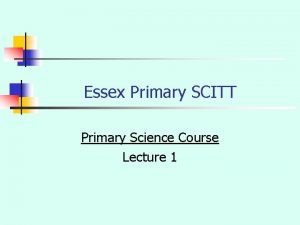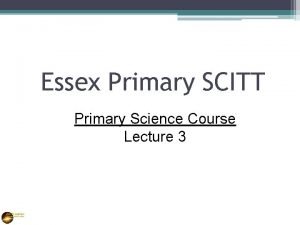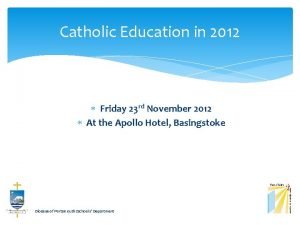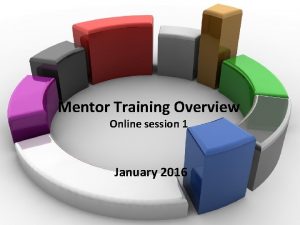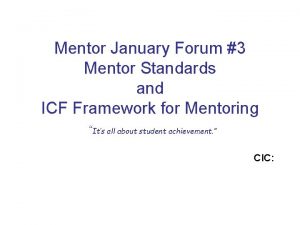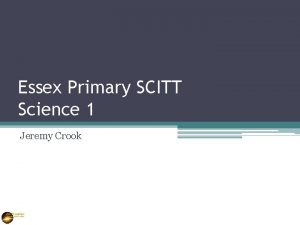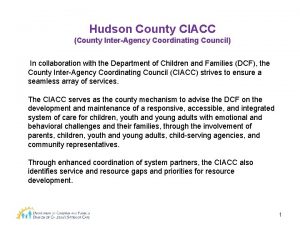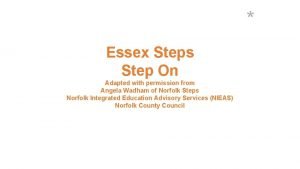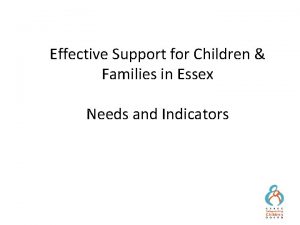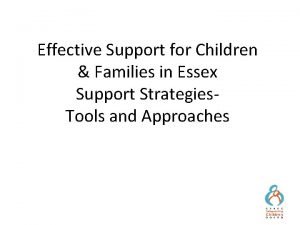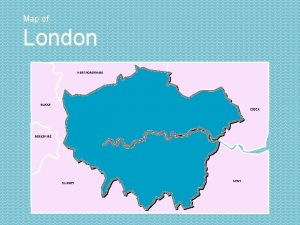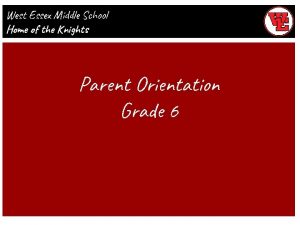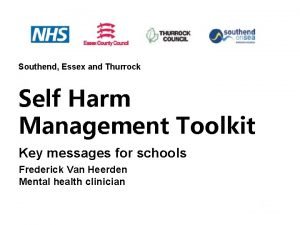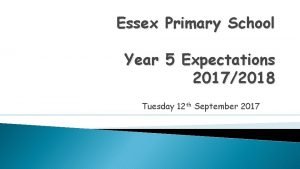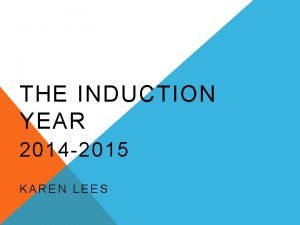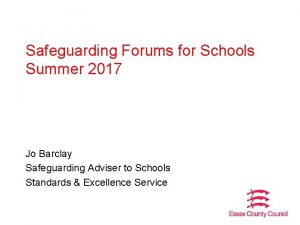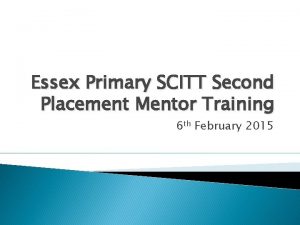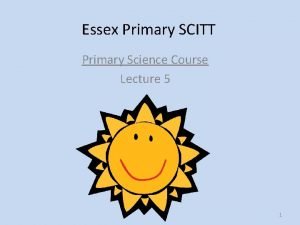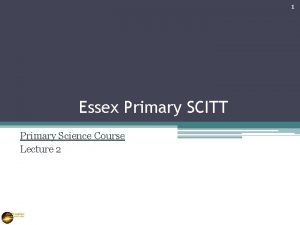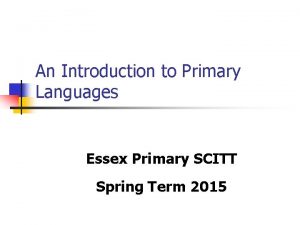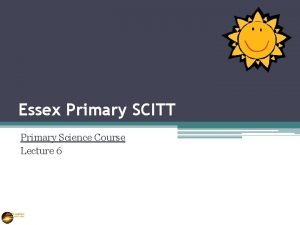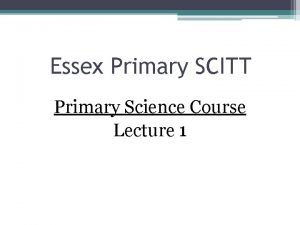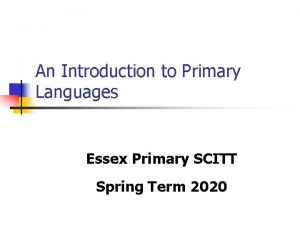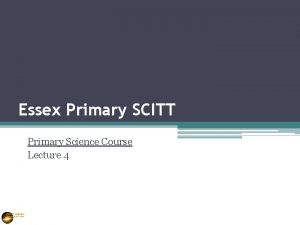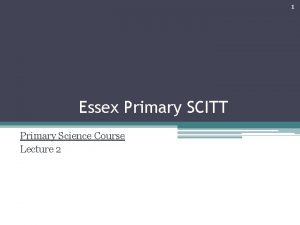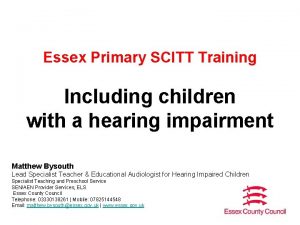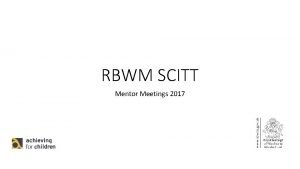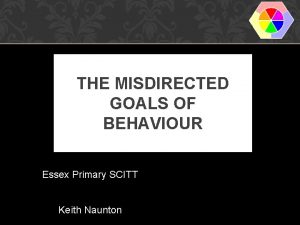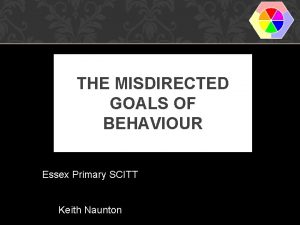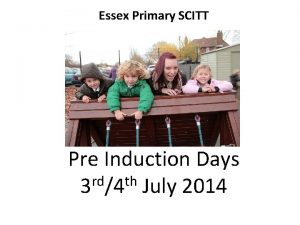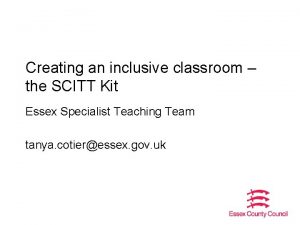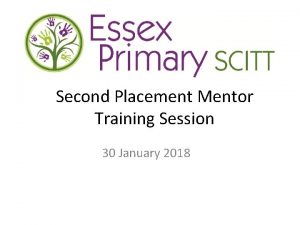Essex Primary SCITT Second Placement Mentor Training 4



































- Slides: 35

Essex Primary SCITT Second Placement Mentor Training 4 th February 2016

To start � Complete the acrossword s d e n c o o c n e d s

An overview of the course � Day 1 – Organising English � Day 2 – A Guide to early reading � Day 3 (i)– Teaching handwriting and spelling � Days 3 (ii) and 4 – Teaching reading � Day 5 – Teaching spoken language

An overview of the course � Day 6 – Teaching writing � Day 7 – Teaching grammar (1) and teaching non-fiction � Day 8 – Teaching grammar (2) and teaching poetry � Day 9 – Teaching grammar (3) + Supporting and challenging all learners � Day 10 – Periodic assessment in English + motivating learners in English

The English Planning Kit �A resource to enable the 2014 Primary National Curriculum for English to be planned and delivered coherently and effectively. � The 2014 Primary English Curriculum provides limited progression and broad objectives. This document provides smaller learning steps based on these and a more detailed progression � It suggests additional objectives where gaps or weaknesses have been identified

How the EPK is organised � Introduction and notes � Termly objectives � Strand progressions � Text type progression � Appendices ◦ Writing style guide ◦ Story structures ◦ Example half termly planner

Strands in the EPK � Spoken ◦ ◦ language Speaking Listening Discussion Drama � Reading ◦ ◦ Word reading Being a reader Comprehension Being a researcher

Strands in the EPK � Writing ◦ ◦ ◦ Planning Composing Evaluating Grammar and vocabulary Punctuation � Transcription ◦ Spelling ◦ Handwriting and Presentation

Comprehension sub-strands � Answering � Clarifying questions � Inferring � Imagining � Predicting � Summarising � Linking � Understanding text organisation � Understanding writers’ use of language (Year 2 onwards) � Understanding purpose and viewpoint (Year 3 onwards)

The English Assessment Kit � Introduction � Individual reading assessment grids � Individual writing assessment grids � Class grids for additional grammar knowledge � Individual spoken language assessment grids � Whole class spoken language quick assessment grids


English Tasks Day 1 � Find out how your school organises the teaching of English. Write a reflective log giving your thoughts and explaining why English is organised in this way. Day 2 � Find out how your school teaches phonics and observe a phonics session. Write a reflective log outlining how this has developed your understanding of effective phonics teaching. Day 3 � For an identified ability group, use your school’s assessment sheets to assess their next steps in reading. Use this information to plan, teach and evaluate a guided reading session.

English Tasks Day 4 � Make a story box or story sack that will help to build some of the reading comprehension objectives in the EPK. Make use of this with a group or class. Evaluate the children’s comprehension skills and the effectiveness of your approach. Day 5 � With a class teach one speaking, listening, drama or discussion objective from the EPK. How successful were you? How do you know? Evaluate the lesson. Day 6 � Plan, deliver and evaluate a shared writing session, including some modelling of writing. Evaluate its effectiveness in supporting children’s independent writing.

English Tasks Day 7 � Complete your reading wall. Select one book and use the teaching sequence for writing to detail how you could use this in a unit of work for your non-placement key stage. Day 8 � Analyse the writing from a group of children solely for their grammar use. What can they do well and what can’t they do? Plan, teach and evaluate an intervention session to teach the group’s next step in grammar. Day 9 � Explain how your subject knowledge in one area of English has deepened over the year.

English Assignment � During your second placement teaching practice you must plan, teach and evaluate a sequence of lessons for a specific unit of work in literacy � Choose a unit of literacy for your teaching sequence that develops pupils’ literacy skills � Research effective learning and teaching approaches/ideas to help plan and deliver this unit � Plan an effective learning sequence � Teach the learning sequence � Evaluate the impact on pupils’ learning � Consider implications for future teaching & learning

EYFS variation � During your second placement teaching practice in EYFS you must plan, teach and evaluate a sequence of adult led and child led activities to develop pupils’ English/literacy skills � Research effective learning and teaching approaches/ideas to help plan and deliver English/literacy in EYFS � Design and plan an effective sequence of learning experiences based on this research that will develop pupils’ English/literacy skills � Teach the sequence � Evaluate the impact on pupils’ learning � Consider implications for future teaching and learning

Possible issues

Moving to a teaching sequence The teaching sequence for writing should sit behind every unit

‘The Knowledge Quartet’ Foundation Overt subject knowledge which the trainee brings to the teaching situation Transformation How well trainees are able to transform what they know in ways that make this knowledge accessible and appropriate to children Contingency The ability to ‘think on one’s feet’. Responding to the unexpected more than the ability to make predictions when planning Connection Decisions about sequencing and connectivity relating to the context of previous lessons and pupils knowledge. This will typically follow from the ability to anticipate what is complex and what is conceptually appropriate for an individual or group of pupils

Subject knowledge in English � Foundation – I know how authors create characters � Transformation – I know how teach this successfully to children so that they can create characters in their writing � Connection – I know when to teach it, how to break it down, how to embed this in a story unit and how to develop it across other units � Contingency – I can deal with misconceptions, weakly or badly written characters and unexpected issues

The teaching sequence for writing 1. 2. 3. 4. 5. 6. 7. Reading Analysing Defining Preparation and planning Shared writing Independent writing Reviewing and publishing Benefits and Perils?

Developing lesson structure to match learning � Different lengths of lesson � Three part lesson � Four part lesson � Learning loops or chunking � Learning episodes � Inductive lesson � Practise and repeat � 2 day lesson Which structure will give the �. . . best learning for that objective?

Threading � Success criteria / writing checklist � Grammar � Vocabulary �. . .

Grammar in context 1. 2. 3. 4. 5. 6. 7. 8. Reading Analysing – Identify grammar used by the author Defining – Add it to the success criteria Preparation – Teach grammar lessons to practise it Planning Shared writing – Model it Writing – Children use it Reviewing and publishing – Children check against success criteria

Vocabulary � Tier 1 – Everyday, basic, familiar words e. g. look � Tier 2 – More sophisticated words but of high utility e. g. glance � Tier 3 – Words that are very rare and words that apply to specific domains e. g. ranch

Which tier are they? � Leaf � Less � Magnesium � Swim � Lurch � Coracle � Limp � Gloom � Pulpit � Cautious � Gracefully � Cellar � Vain � Clear

The ‘robust vocabulary’ approach 1. 2. 3. 4. 5. 6. Choose a set of tier 2 words that have mileage from your text Introduce in context Provide friendly explanations Provide some additional contexts Build in lots of opportunities to use the words Add to success criteria

Linking to the teaching sequence 1. 2. 3. 4. 5. 6. 7. 8. Reading Analysing – Identify vocabulary used by the author Defining – Add it to the success criteria Preparation – Practise it Planning Shared writing – Model it Writing – Children use it Reviewing and publishing – Children check against success criteria

Strategies for reading � Shared reading � Active reading ◦ ◦ ◦ ◦ ◦ Highlighting / underlining Questioning Drama Cloze Sequencing Text restructuring Writing from reading Labelling Visualisation Diagrammatic representation � Analysing for language features and text structure (writer’s toolkit, boxing up, working wall)

Strategies for preparation and planning � Practising grammar and vocabulary � Using a range of stimuli � Planning fiction � Planning non-fiction

Strategies for writing � Multiple outcomes and/ or redrafting � Say, write, check � Shared writing ◦ Demonstration ◦ Scribed ◦ Supported composition � Independent writing � Guided writing to fill gaps � Reviewing ◦ Revising ◦ Editing ◦ Proof reading � Publishing

Key messages for EYFS � Adult led and child led � Developmental and direct instruction � Exploring all aspects of English � Use of phonics � The importance of speaking and listening � Maybe based around a central topic / book

Putting it together � What do you need to teach? � What will your outcome(s) be (form and audience)? � What text(s) will you use as a model? � What success criteria will you pull out of analysing the text? � Which skills/ grammar/ vocabulary might you have to directly teach or model? � How will you structure the unit? � How would you prepare / stimulate the children to write? � How will assessment for learning thread through the unit

Our ultimate aim � For students to be able to plan an successful English unit of work from just the objectives and the text.

Next steps What are your steps in getting them to that point? � What might the threats be to getting them there? � What might have to change? � How can you help? � Where do you anticipate they will need the most support? �
 West essex scitt
West essex scitt Essex primary scitt
Essex primary scitt Essex primary scitt
Essex primary scitt West essex primary care trust
West essex primary care trust Essex construction training
Essex construction training Iosh training essex
Iosh training essex Pcp scitt
Pcp scitt Scitt moir
Scitt moir Scitt moir
Scitt moir Science enquiry types
Science enquiry types Ctsn scitt
Ctsn scitt Ctsn scitt
Ctsn scitt 27 miles per gallon into kilometers per liter
27 miles per gallon into kilometers per liter American hero poem analysis
American hero poem analysis Oates essex
Oates essex Ciacc essex county
Ciacc essex county Essex steps
Essex steps Effective support for families in essex
Effective support for families in essex Essex wessex mercia northumbria
Essex wessex mercia northumbria American hero essex hemphill
American hero essex hemphill Families in focus essex
Families in focus essex Effective support for children and families in essex
Effective support for children and families in essex Hudson essex passaic soil conservation district
Hudson essex passaic soil conservation district Essex to berkshire
Essex to berkshire Joint meeting essex and union county
Joint meeting essex and union county Damion macioci
Damion macioci Self harm toolkit essex
Self harm toolkit essex 7 minute safeguarding briefings essex
7 minute safeguarding briefings essex Fairplay house essex
Fairplay house essex Essex infolink
Essex infolink Oase carpiene
Oase carpiene Classification de mason coude
Classification de mason coude Nqt manager essex
Nqt manager essex Anglo saxon england map
Anglo saxon england map Jo barclay essex safeguarding
Jo barclay essex safeguarding Essex infolink safeguarding
Essex infolink safeguarding
